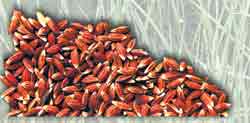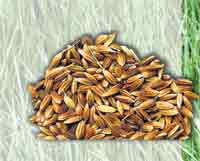
Sowing a passionSome farmers are rediscovering the legacy of ancient paddy cultivators by going back to traditional seeds In our current pre-occupation with rice shortages and soaring prices, many have forgotten that there was a time when we partook of a different kind of rice for different events like births, and celebrations, toil and sickness. Up until a few decades ago research indicates that Sri Lankan tables hosted nearly 350 different varieties of rice; going even further back, estimates range as high as 3000 varieties. Today, the green revolution has changed the way farmers cultivate their paddy, but a few growers are re-discovering the legacy of generations of ancient paddy farmers – and varieties like Maavee, Poloyal and Hondaravalu are once again on their dining tables.
Saman Wijesinghe has worked with the Ceylon Electricity Board for nearly two decades, but he remains a paddy farmer at heart. Even as a child, he remembers harbouring a passion for farming. “It comes from my ancestral line,” he says, explaining that both his parents were the product of many generations of “very clever rice farmers”. He has documents that date his family’s ownership of the land he now sows, to more than 250 years. And though he may not rely on the produce of his fields for a livelihood, Mr. Wijesinghe is known in his home village of Nungamuwa (about four km north of Veyangoda) not only as a skilful sower, but also as a sower of unusual seeds. Beginning in 2004, he has cultivated several varieties of indigenous rice with success. On the day we drive down to visit him, he presents 11 varieties for our inspection. They range from deep black, through shades of rust and into the purest gold. They vary in size too, with some appearing plump and large, others delicate and tiny. This variety in texture, size and colour is typical of traditional rice varieties, says Mr. Wijesinghe, adding that the uniqueness of the grains displayed is equally reflected in the flavour each offers. Recalling his first forays into cultivating these neglected varieties, he says that he was surprised and then fascinated by the interaction of the plant and its surrounding environment. It was apparent that generations of farmers had tailor-grown these plants to suit the Sri Lankan landscape. The plants sprouted with ease, and required almost nothing in the way of inputs. Recalling the floods that plagued crop growers island-wide in 2006, Mr. Wijesinghe says his own fields were planted with four traditional varieties, and that though he lost them all to the flood that lasted 35 days, they were still alive and would have recovered, despite being entirely submerged, even after the first 14 days. Similarly, indigenous varieties have been found to cope with drought, and even salinity in the soil. Having grown the hybrid varieties previously, Mr. Wijesinghe says that in comparison the traditional varieties of rice do not yield as much at harvest time. While the popular hybrid varieties can be harvested within 3 to 4 ½ months, roughly, traditional varieties may take anything from two months to seven. However, Mr. Wijesinghe believes this is balanced out because the cultivation of indigenous varieties like Ranthembiliel is dramatically cheaper, as it requires nothing in the way of artificial manure, pesticides or weedicides. Labour is also saved, as these varieties seem to thrive on coarse soil and do not require the field to be puddled. In addition, they are much hardier – exhibiting higher resistance to fluctuating weather conditions, varied soil conditions and attacks from pests, even as the grains themselves retain their vitality for exponentially longer periods.
But it is in the actual eating that you most appreciate the traditional varieties, says his friend Leel Randeni. Mr. Randeni works in the Environmental Ministry, as a senior environment management officer, based in the promotional environmental education division. He too is passionate about paddy farming, and together with two of his brothers grows enough rice to feed their families. Describing the delicious flavours of traditional rice varieties, Mr. Randeni also waxes lyrical about their wonderful aromas and nutritional properties. “Over many years of inbreeding, the properties have become stronger and more defined – some are medicinal, some are aromatic, some are very rich in nutrients, and some are simply tasty,” he says. For instance, the variety known as Pachchaperumal was often used in alms givings, because the big, black grains provided a hearty meal. Similarly Murungu Kayam was known to sustain those involved in heavy physical labour. Suwandel was renowned for its glorious aroma, while Kaluheenati was cooked into herbal porridges. Today, Mr. Randeni’s own children, like generations of little ones gone by, love the light, tiny grains known as Uru Vee. Referring to published research on the subject, Mr. Randeni explains that traditional varieties are known to contain higher amounts of glutamic acid, higher concentrations of vitamins and the coarse grains are also richer in fibre content. Despite all these obvious benefits the lack of a “bumper crop” makes it difficult to convince local farmers to give these old varieties a shot, and as a result they are quickly disappearing, says Mr. Wijesinghe. While the occasional distributor and the adventurous farmer also contribute to their catalogue, such enthusiasts are few and far between. Despite this, the duo has taken to giving farmers around the area traditional varieties to be used as seed paddy. They insist, however, that the farmers use the crop to feed themselves and their families and not for commercial purposes. In doing so, they hope that small farmers will re-discover the goodness of these varieties, even as they realise that a smaller harvest is not necessarily a bad thing. Describing the tendency of the traditional grains to swell upon cooking, Mr. Randeni says a comparatively smaller amount of these grains is enough to provide hearty eating. Towards the end of our interview, we head out to the paddy fields themselves, where Mr. Wijesinghe shows us a lush ratoon crop – meaning a crop that has grown on its own, from the grains and stubble left after the last harvest. The only sign of any human intervention is the hay spread over the field, an old practice known to improve the quality of the soil. “Without having spent a single cent, I have this entire section covered in luscious growth,” says Mr. Wijesinghe with evident satisfaction, noting that the crop will be ready for harvesting - and his table - in a matter of months. Varieties not viable While some farmers may opt to grow traditional varieties because they prize its specific characteristics, a vast majority of farmers cannot afford to consider the traditional varieties for cultivation, says Nimal Dissanayake, Director of the Rice Research and Development Institute in Batalagoda. He says at a time where the government is trying to get the most out of every inch of land under cultivation, these varieties are simply not viable. Some farmers may consider growing these varieties for speciality markets, and some traditional varieties are even available in some of the supermarkets, but these could be too expensive for the average consumer. As part of their Rice Improvement Programme, Mr. Dissanayake says the Institute is continuously working on incorporating some of the valuable characteristics found in traditional varieties (such as higher tolerance for flood conditions) into the hybrids. Drawing from a catalogue of 700 to 800 varieties, the Institute continues to experiment with the hybrids that they believe are our most viable source of rice for the future. |
|
||||||
|| Front
Page | News | Editorial | Columns | Sports | Plus | Financial
Times | International | Mirror | TV
Times | Funday
Times || |
| |
Reproduction of articles permitted when used without any alterations to contents and a link to the source page.
|
© Copyright
2008 | Wijeya
Newspapers Ltd.Colombo. Sri Lanka. All Rights Reserved. |



